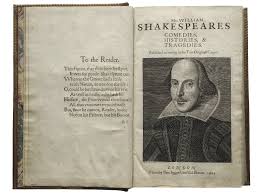Henry Clay Folger, Jr. was president and later chairman of Standard Oil of New York, a collector of Shakespeareana, and founder of the Folger Shakespeare Library.
Folger was an avid collector of Shakespeareana, assembling the world's largest collection of First Folio editions of Shakespeare's plays.
The first rare book Folger acquired was a 1685 copy of the Fourth Folio, purchased
in 1889 for $107.50. He purchased his first original copy of the First Folio four years later, in 1893. Unlike other wealthy collectors of the period, like Henry E. Huntington and J.P. Morgan, Folger favored "imperfect" copies of rare volumes, with their marginalia and other markings. Following this trend, his Folio collection was marked with diversity in provenance and condition.
He preferred to purchase Early Editions of books published between 1567 and 1606, in addition to manuscripts of the period. Based on their collective knowledge of Latin and French, and Emily's proficiency in German, the couple also favored rare volumes published on the Continent in the sixteenth and seventeenth centuries. The couple was less interested in art collection, and many of the Shakespeare-related paintings they purchased were misattributed to artists like Thomas Gainsborough.
The Folgers chose items to purchase from booksellers' catalogues, which were initially perused and marked up by Emily, before she passed them on to Henry, who kept an extensive and precise list of items he intended to bid on. If possible, he inspected an item personally before purchasing it. He also avoided consulting scholarly experts about rare volumes, preferring his own and Emily's expertise, as she received an M.A. from Vassar College in 1896 for a thesis on Shakespeare. Folger used professional booksellers as middlemen at auctions, believing that the concealment of his identity would keep prices low. Few of the Folgers' acquisitions were stored in their living space. Emily entered purchases into an extensive card catalog housed in a Brooklyn Standard Oil warehouse, which also stored rare books in ten-gallon oil cases. The most valuable items were kept in bank vaults.
Folger financed a half-century of collecting with his Standard Oil salary and extensive investments in the company. His high placement at Standard Oil also allowed him to take out loans with his friend Charles Millard Pratt, John D. Rockefeller, and even his wife, to fund his purchases. He generally paid for items in cash, a strategy that earned him the favor of many booksellers who needed immediate funds. Folger also preferred to purchase whole collections, like the Halliwell-Phillipps collection, acquired in 1908, because bulk purchases drove down prices of individual items.
Toward the end of World War I, Folger and his wife began searching for a location for his Shakespeare library. Among the sites he and Emily considered were Amherst and Nantucket, Massachusetts, the University of Chicago, New York City, and Stratford-upon-Avon, before they settled on a Washington, D.C. site they discovered in 1918 during a layover in the city while traveling to Hot Springs. Folger spent nine years purchasing the fourteen row houses that occupied the block of East Capitol Street between First and Second Streets, which he would demolish to build his Library; thus, they did not make their choice of a site on Capitol Hill public until 1928. Soon afterwards, Congress passed a resolution allowing use of the land on East Capitol Street where the Folger Shakespeare Library now stands.
Get a Daily Dose of Literary History: Like and Follow Blind Horse Books.
Building Great Collections, One Fine Book at a Time
Visit us at BlindHorseBooks.com
#HenryClayFolger #FolgerLibrary
Building Great Collections, One Fine Book at a Time
Visit us at BlindHorseBooks.com
#HenryClayFolger #FolgerLibrary






Comments
Post a Comment